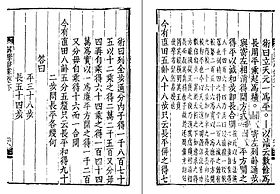| This article includes a list of general references, but it lacks sufficient corresponding inline citations. Please help to improve this article by introducing more precise citations. (January 2013) (Learn how and when to remove this message) |

Zhu Shijie (simplified Chinese: 朱世杰; traditional Chinese: 朱世傑; pinyin: Zhū Shìjié; Wade–Giles: Chu Shih-chieh, 1249–1314), courtesy name Hanqing (漢卿), pseudonym Songting (松庭), was a Chinese mathematician and writer during the Yuan Dynasty. Zhu was born close to today's Beijing. Two of his mathematical works have survived: Introduction to Computational Studies (算學啓蒙 Suan hsüeh Ch'i-mong) and Jade Mirror of the Four Unknowns.
Suanxue qimeng

The Suanxue qimeng (算學啓蒙), written in 1299, is an elementary textbook on mathematics in three volumes, 20 chapters and 259 problems. This book also showed how to measure two-dimensional shapes and three-dimensional solids. The Introduction strongly influenced the development of mathematics in Japan. The book was once lost in China, until the Qing dynasty mathematician Luo Shilin bought a Korean printed edition and republished it in Yangzhou.
Jade Mirror of the Four Unknowns

Zhu's second book, Jade Mirror of the Four Unknowns (1303) is his most important work, advancing Chinese algebra. The first four of the 288 solved problems illustrate his method of the four unknowns. He shows how to convert a problem stated verbally into a system of polynomial equations (up to 14th order), by using up to four unknowns: 天 Heaven, 地 Earth, 人 Man, 物 Matter, and then how to reduce the system to a single polynomial equation in one unknown by successive elimination of unknowns. He then solves the high order equation by "Ling long kai fang" method of Southern Song dynasty mathematician Qin Jiushao (from Shùshū Jiǔzhāng, “Mathematical Treatise in Nine Sections” of 1247). This was more than 570 years before English mathematician William Horner's method using synthetic division. Zhu makes use of what is currently known as Pascal's triangle, which he refers to as discovered by Jia Xian before 1050. The final equation and one of its solutions is given for each of the 288 problems.
Zhu also found square and cube roots by solving quadratic and cubic equations, and added to the understanding of series and progressions, classifying them according to the coefficients of the Pascal triangle. He also showed how to solve systems of linear equations by reducing the matrix of their coefficients to diagonal form. He moreover applied these methods to algebraic equations, using a version of the resultant. His methods pre-date Blaise Pascal, William Horner, and modern matrix methods by many centuries. The preface of the book describes how Zhu traveled China for 20 years teaching mathematics.
The methods of Jade Mirror of the Four Unknowns form the foundation for Wu's method of characteristic set.
References
- "Zhu Shijie - Biography". Maths History. Retrieved 2023-07-03.
- Mumford 2010, p. 122.
- Du, Shiran, "Zhu Shijie". Encyclopedia of China (Mathematics Edition), 1st ed.
- GRATTAN-GUINNESS, I.: The Norton History of the Mathematical Sciences, 1998.
- Guo Shuchun (tr. modern Chinese), Chen Zaixin (English tr.), Guo Jinhai (annotation), Zhu Shijie: Jade mirror of the Four Unknowns, Chinese and English bilingual, vol I & 2, Liaoning education Press, China, 2006. ISBN 7-5382-6923-1
- HO Peng-Yoke: Article on Chu Shih-chieh in the Dictionary of Scientific Biography, New York, 1970.hi
- Hoe, J.: The jade mirror of the four unknowns, Mingming Bookroom, New Zealand, 2007. ISBN 1-877209-14-7
- Hoe, J.: Les systèmes d'équations polynômes dans le Siyuan Yujian (1303), Paris, Collège de France (Mémoires de l'Institut des Hautes Etudes Chinoises, Vol VI),1977.
- KONANTZ, E.L.:The Precious Mirror of the Four Elements, China journal of Science and Arts, Vol 2, No 4, 1924.
- LAM Lay-yong: Chu shih-chieh's Suan hsüeh ch'i-meng, Archive for the history of sciences, Vol 21, Berlin, 1970.
- MARTZLOFF, J-C.: A history of Chinese Mathematics, Springer-Verlag, Berlin, 1997.
- MIKAMI Yoshio, Development of Mathematics in China and Japan, Chapter 14 Chu Shih-chieh p89-98. 1913 Leipzig. Library of Congress catalog card number 61-13497.
- Mumford, David, "What’s so Baffling About Negative Numbers? — a Cross-Cultural Comparison", in C. S. Seshadri (Ed.), Studies in the History of Indian Mathematics, 2010.
External links
- O'Connor, John J.; Robertson, Edmund F., "Zhu Shijie", MacTutor History of Mathematics Archive, University of St Andrews